

Compact Muon Solenoid
LHC, CERN
| CMS-PAS-HIN-19-009 | ||
| Studies of charm and beauty long-range correlations in pp and pPb collisions | ||
| CMS Collaboration | ||
| November 2019 | ||
| Abstract: Studies of collective long-range (large η gap) correlations involving open charm and beauty hadrons in pp and pPb collisions are presented, using data samples collected by the CMS experiment with center-of-mass energies of 13 and 8.16 TeV, respectively. The elliptic flow harmonics (v2) of prompt and nonprompt D0 mesons (from beauty hadron decays) are extracted from long-range two-particle azimuthal correlations, with respect to inclusive charged particles. In pp collisions, positive v2 signals for prompt charm hadrons are reported for the first time over a transverse momentum (pT) range of 2-4 GeV. The signals are comparable to those for light-flavor hadron species. Compared at similar event multiplicities, the prompt D0 meson v2 values in pp and pPb are similar in magnitude. The v2 signal for open beauty hadrons is extracted for the first time via nonprompt D0 meson in pPb collisions, with a magnitude smaller than that for prompt D0 meson at pT between 2-5 GeV. The new measurements provide strong indications of a postive charm hadron v2 in the smallest pp systems and a flavor hierarchy of v2 between charm and beauty hadrons in the pPb systems, providing key insights to further understand the origin of heavy flavor quark collectivity in small-system collisions. | ||
|
Links:
CDS record (PDF) ;
CADI line (restricted) ;
These preliminary results are superseded in this paper, PLB 813 (2021) 136036. The superseded preliminary plots can be found here. |
||
| Figures | Summary | Additional Figures | References | CMS Publications |
|---|
| Figures | |
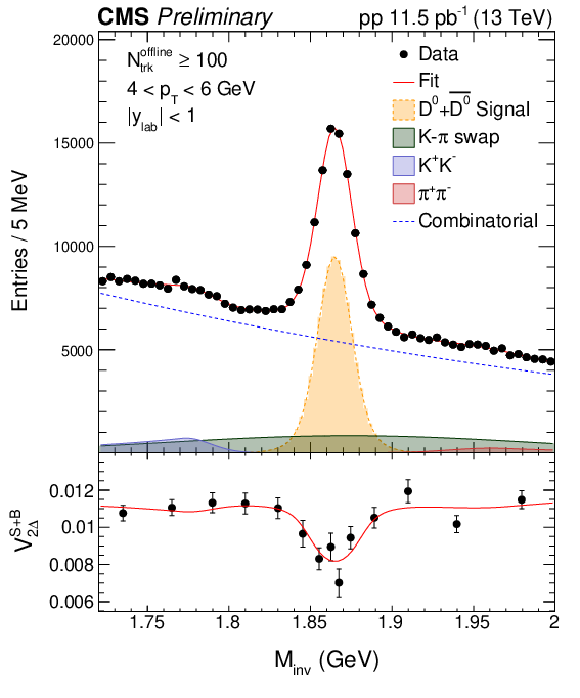
png pdf |
Figure 1:
Example of fits to the invariant mass spectrum and VS+B2Δ(minv), for the BDT prompt-trained sample in pp collisions. |
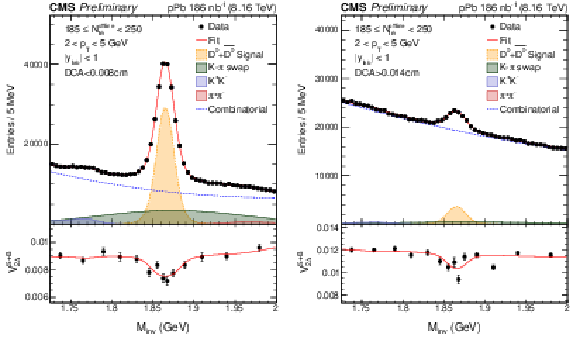
png pdf |
Figure 2:
Example of fits to the invariant mass spectrum and VS+B2Δ(minv), for the BDT nonprompt-trained sample in pPb collisions. The left shows the fit for DCA<0.008 cm and the right is for DCA>0.014 cm. |
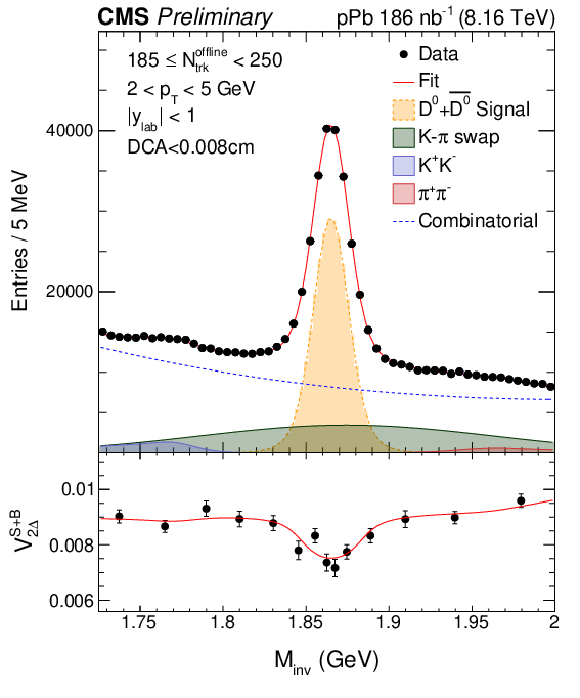
png pdf |
Figure 2-a:
Example of fit to the invariant mass spectrum and VS+B2Δ(minv), for the BDT nonprompt-trained sample in pPb collisions. The plot shows the fit for DCA<0.008 cm. |
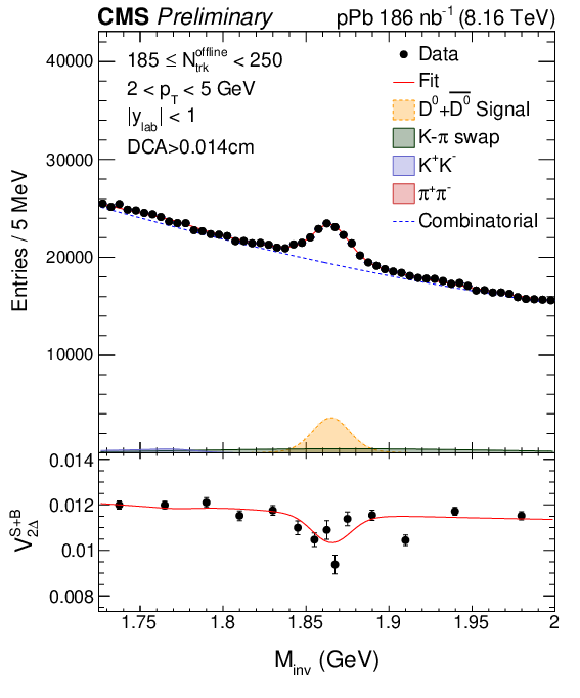
png pdf |
Figure 2-b:
Example of fit to the invariant mass spectrum and VS+B2Δ(minv), for the BDT nonprompt-trained sample in pPb collisions. The plot shows the fit for DCA>0.014 cm. |
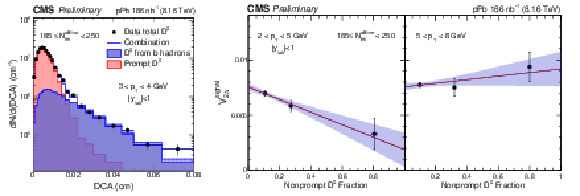
png pdf |
Figure 3:
Left: example of template fit to D0 DCA distribution in the pT interval 3-4 GeV for events with185 ≤Nofflinetrk< 250 of pPb collisions. Middle and right: inclusive D0 Vsignal2Δ values from the three DCA regions as a function of the corresponding nonprompt D0 fraction, for 2 <pT< 5 GeV and 5 <pT< 8 GeV. The red line is a linear fit to Vsignal2Δ |
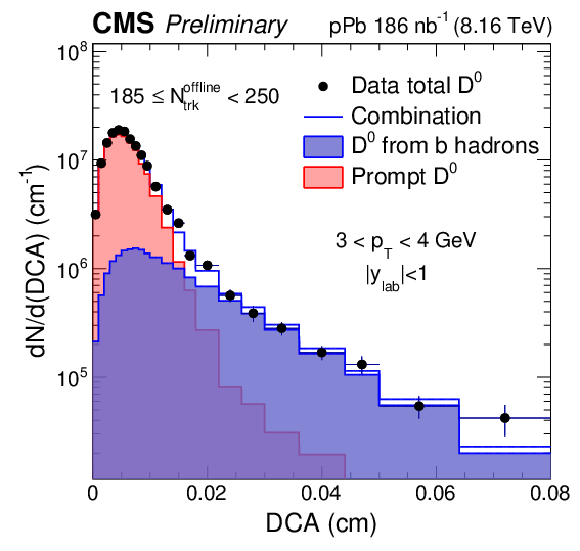
png pdf |
Figure 3-a:
Example of template fit to D0 DCA distribution in the pT interval 3-4 GeV for events with185 ≤Nofflinetrk< 250 of pPb collisions. |
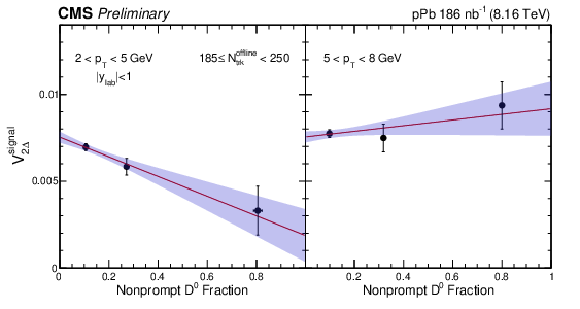
png pdf |
Figure 3-b:
Inclusive D0 Vsignal2Δ values from the three DCA regions as a function of the corresponding nonprompt D0 fraction, for 2 <pT< 5 GeV and 5 <pT< 8 GeV. The red line is a linear fit to Vsignal2Δ |
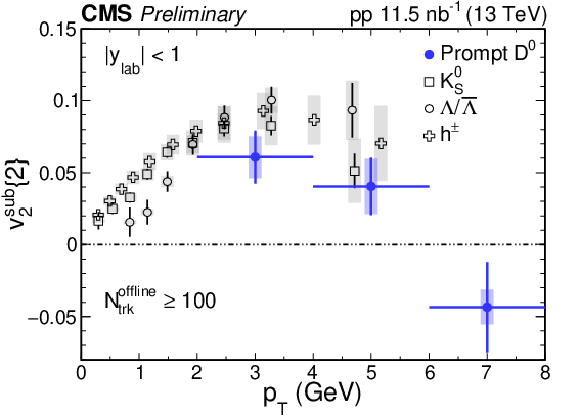
png pdf |
Figure 4:
Results of elliptic flow (vsub2) for prompt D0 mesons, as a function of pT for |y|< 1, with Nofflinetrk≥ 100 in pp collisions at √s= 13 TeV. Published data for charged particles, K0S and Λ are also shown for comparison [17]. The error bars correspond to statistical uncertainties, while the shaded areas denote the systematic uncertainties. The horizontal error bars represent the width of the pT bins. |
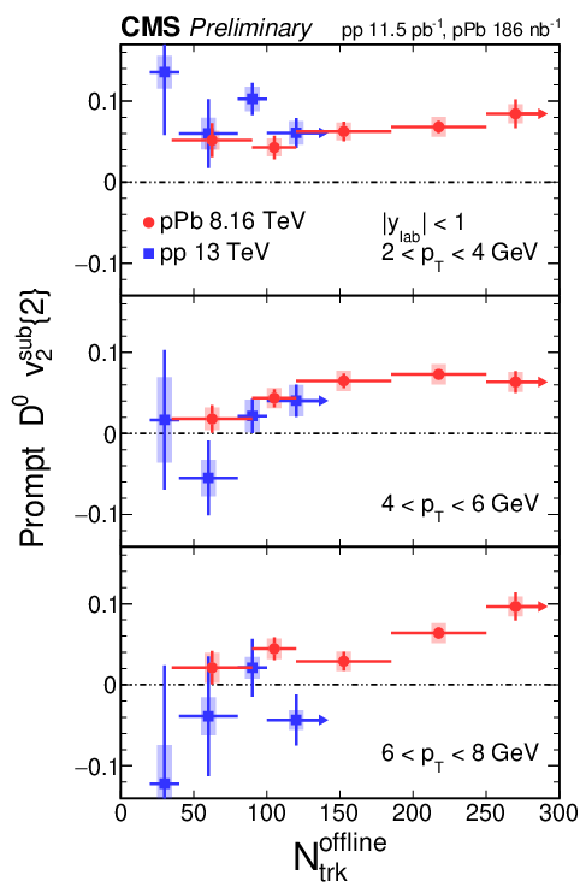
png pdf |
Figure 5:
Results of elliptic flow (vsub2) for prompt D0 mesons, as a function of event multiplicity for three different pT ranges, with |y|< 1 in pp collisions at √s=13 TeV and pPb collisions at √sNN= 8.16 TeV. The vertical error bars correspond to statistical uncertainties, while the shaded areas denote the systematic uncertainties. The horizontal error bars represent the width of the Nofflinetrk bins. The right-most points with right-arrows correspond to Nofflinetrk≥ 100 for pp collisions and Nofflinetrk≥ 250 for pPb collisions. |
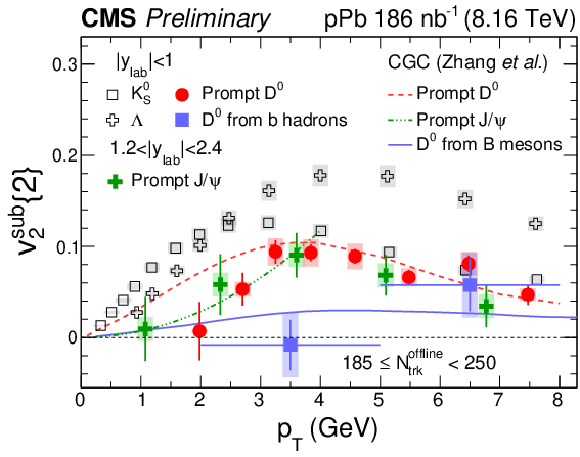
png pdf |
Figure 6:
Results of elliptic flow (vsub2) for prompt and nonprompt D0 mesons, as well as K0S, Λ for |ylab|< 1, and J/ψ for 1.2 <|ylab|< 2.4, as functions of pT with 185 ≤Nofflinetrk< 250 in pPb collisions at √sNN= 8.16 TeV [48,50]. The error bars correspond to statistical uncertainties, while the shaded areas denote the systematic uncertainties. The horizontal error bars represent the width of the nonprompt D0 pT bins. Dash line, dash-dotted line and solid line show the theoretical calculation of prompt D0, J/ψ and nonprompt D0 under color glass condensate (CGC) framework respectively [52]. |
| Summary |
| The first measurements of elliptic azimuthal anisotropies for prompt D0 mesons in pp collisions at √sNN= 13 TeV, and for nonprompt D0 mesons from beauty hadron decays in pPb collisions at √sNN= 8.16 TeV are presented. In pp collisions with Nofflinetrk≥ 100, strong indications of positive v2 signals for prompt charm hadrons are reported for the first time over a transverse momentum (pT) range of 2-4 GeV, which is found to be comparable (or slightly smaller) to those for light-flavor hadron species. Compared at similar event multiplicities, the prompt D0 meson v2 values in pp and pPb are found to be similar in magnitude. The v2 signal of open beauty hadrons is extracted for the first time via non-prompt D0 meson in pPb collisions, with a magnitude smaller than that for prompt D0 mesons at pT∼ 3-4 GeV. The new measurements of charm hadron v2 in the smallest pp system and the strong indications of mass dependence of heavy flavor hadron v2 in the pPb system provide key insights to understand the origin of heavy flavor quark collectivity in small-system collisions. |
| Additional Figures | |
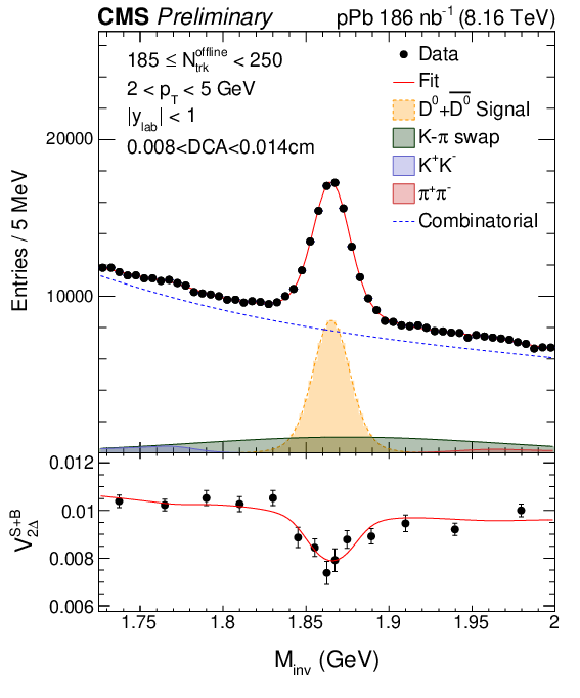
png pdf |
Additional Figure 1:
Example of fits to the invariant mass spectrum and VS+B2Δ(minv), for the BDT nonprompt-trained sample in pPb collisions with 0.008 <DCA< 0.014 cm. |
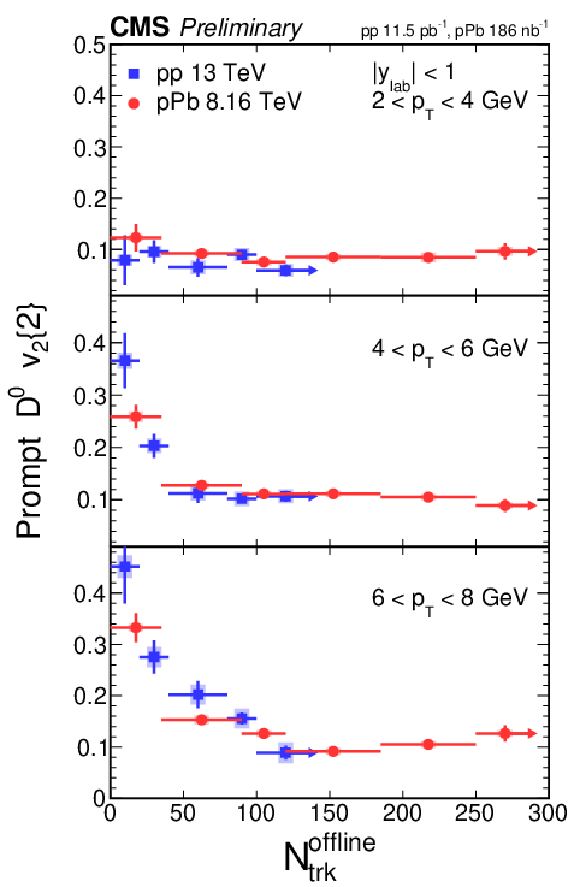
png pdf |
Additional Figure 2:
Results of elliptic flow (v2) without non-flow subtraction for prompt D0 mesons, as a function of event multiplicity for three different pT ranges, with |y|< 1 in pp collisions at √s= 13 TeV and pPb collisions at √sNN= 8.16 TeV. The vertical error bars correspond to statistical uncertainties, while the shaded areas denote the systematic uncertainties. The horizontal error bars represent the width of the Nofflinetrk bins. The right-most points with right-arrows, correspond to Nofflinetrk≥ 100 for pp collisions, and Nofflinetrk≥ 250 for pPb collisions. |
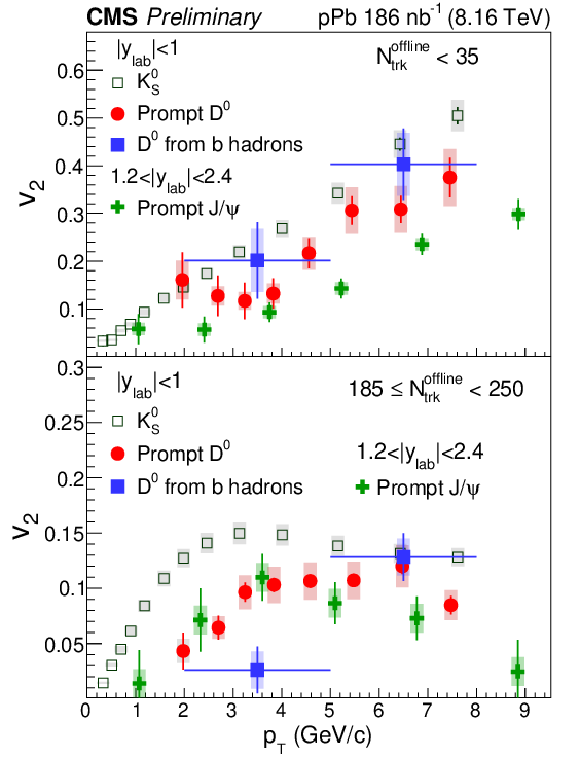
png pdf |
Additional Figure 3:
Results of elliptic flow (v2) without non-flow subtraction for prompt, nonprompt D0 mesons and K0S for |ylab|< 1 and J/ψ for 1.2 <|ylab|< 2.4, as functions of pT with Nofflinetrk< 35 (top) and 185 ≤Nofflinetrk< 250 (bottom) in pPb collisions at √sNN= 8.16 TeV [1,2]. The error bars correspond to statistical uncertainties, while the shaded areas denote the systematic uncertainties. |
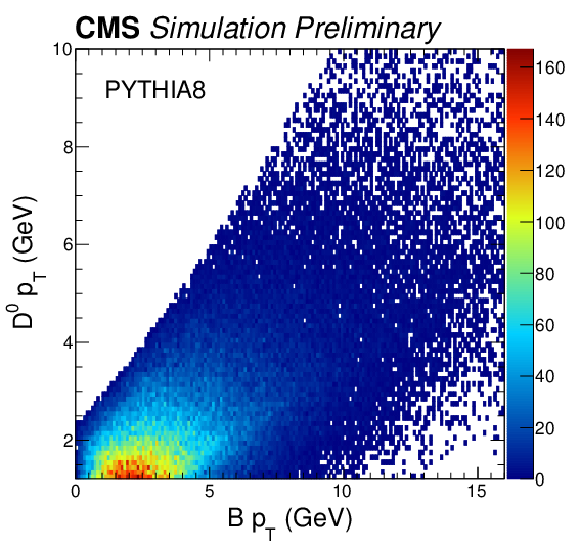
png pdf |
Additional Figure 4:
PYTHIA 8 simulation of the correlation between B and nonprompt D0 pT. |
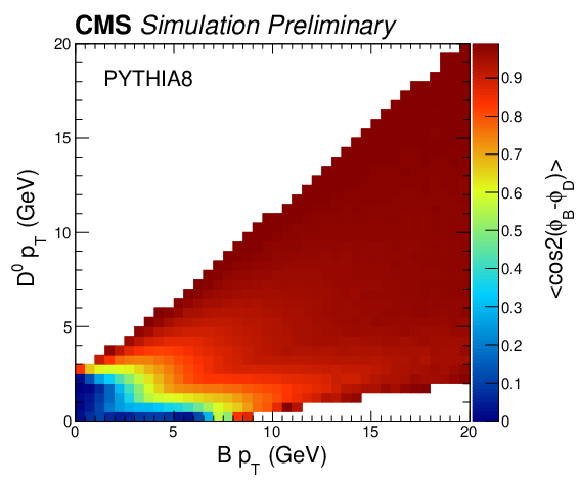
png pdf |
Additional Figure 5:
PYTHIA 8 simulation of the pT dependence of cos2(ϕB−ϕD0) for B and nonprompt D0. |
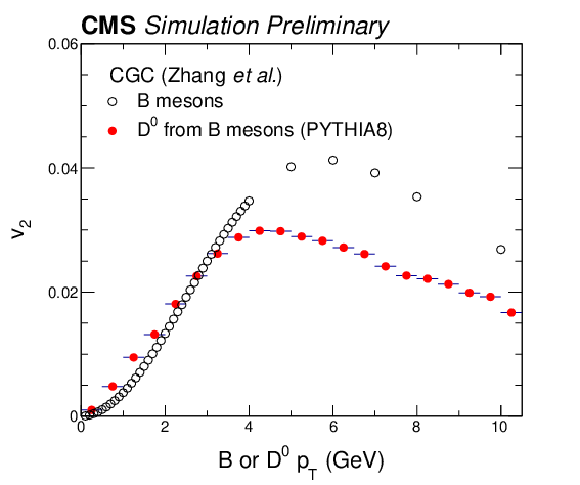
png pdf |
Additional Figure 6:
Predicted v2 of B and nonprompt D0 under CGC framework [3]. v2 of nonprompt D0 is from convolution of v2 of B and PYTHIA 8 simulation. |
| References | ||||
| 1 | PHOBOS Collaboration | System size dependence of cluster properties from two- particle angular correlations in Cu+Cu and Au+Au collisions at √sNN = 200 GeV | PRC 81 (2010) 024904 | 0812.1172 |
| 2 | STAR Collaboration | Distributions of charged hadrons associated with high transverse momentum particles in pp and Au + Au collisions at √sNN = 200 GeV | PRL 95 (2005) 152301 | nucl-ex/0501016 |
| 3 | STAR Collaboration | Long range rapidity correlations and jet production in high energy nuclear collisions | PRC 80 (2009) 064912 | 0909.0191 |
| 4 | PHOBOS Collaboration | High transverse momentum triggered correlations over a large pseudorapidity acceptance in Au+Au collisions at √sNN = 200 GeV | PRL 104 (2010) 062301 | 0903.2811 |
| 5 | CMS Collaboration | Long-range and short-range dihadron angular correlations in central PbPb collisions at a nucleon-nucleon center of mass energy of 2.76 TeV | JHEP 07 (2011) 076 | CMS-HIN-11-001 1105.2438 |
| 6 | CMS Collaboration | Centrality dependence of dihadron correlations and azimuthal anisotropy harmonics in PbPb collisions at √sNN = 2.76 TeV | EPJC 72 (2012) 2012 | CMS-HIN-11-006 1201.3158 |
| 7 | ALICE Collaboration | Elliptic flow of charged particles in Pb-Pb collisions at 2.76 TeV | PRL 105 (2010) 252302 | 1011.3914 |
| 8 | ATLAS Collaboration | Measurement of the azimuthal anisotropy for charged particle production in √sNN = 2.76 TeV lead-lead collisions with the ATLAS detector | PRC 86 (2012) 014907 | 1203.3087 |
| 9 | CMS Collaboration | Measurement of the elliptic anisotropy of charged particles produced in PbPb collisions at nucleon-nucleon center-of-mass energy = 2.76 TeV | PRC 87 (2013) 014902 | CMS-HIN-10-002 1204.1409 |
| 10 | CMS Collaboration | Studies of azimuthal dihadron correlations in ultra-central PbPb collisions at √sNN = 2.76 TeV | JHEP 02 (2014) 088 | CMS-HIN-12-011 1312.1845 |
| 11 | J.-Y. Ollitrault | Anisotropy as a signature of transverse collective flow | PRD 46 (1992) 229 | |
| 12 | U. Heinz and R. Snellings | Collective flow and viscosity in relativistic heavy-ion collisions | Ann. Rev. Nucl. Part. Sci. 63 (2013) 123 | 1301.2826 |
| 13 | C. Gale, S. Jeon, and B. Schenke | Hydrodynamic Modeling of Heavy-Ion Collisions | Int. J. Mod. Phys. A 28 (2013) 1340011 | 1301.5893 |
| 14 | CMS Collaboration | Observation of Long-Range Near-Side Angular Correlations in Proton-Proton Collisions at the LHC | JHEP 09 (2010) 091 | CMS-QCD-10-002 1009.4122 |
| 15 | ATLAS Collaboration | Observation of long-range elliptic anisotropies in √s= 13 and 2.76 TeVpp collisions with the ATLAS detector | 1509.04776 | |
| 16 | CMS Collaboration | Measurement of long-range near-side two-particle angular correlations in pp collisions at √s= 13 TeV | CMS-FSQ-15-002 1510.03068 |
|
| 17 | CMS Collaboration | Evidence for collectivity in pp collisions at the LHC | PLB 765 (2017) 193 | CMS-HIN-16-010 1606.06198 |
| 18 | ATLAS Collaboration | Measurement of azimuthal anisotropy of muons from charm and bottom hadrons in pp collisions at √s= 13 TeV with the ATLAS detector | 1909.01650 | |
| 19 | CMS Collaboration | Observation of long-range near-side angular correlations in proton-lead collisions at the LHC | PLB 718 (2013) 795 | CMS-HIN-12-015 1210.5482 |
| 20 | ALICE Collaboration | Long-range angular correlations on the near and away side in pPb collisions at √sNN = 5.02 TeV | PLB 719 (2013) 29 | 1212.2001 |
| 21 | ATLAS Collaboration | Observation of associated near-side and away-side long-range correlations in √sNN= 5.02 TeV proton-lead collisions with the ATLAS detector | PRL 110 (2013) 182302 | 1212.5198 |
| 22 | LHCb Collaboration | Measurements of long-range near-side angular correlations in √sNN= 5 TeV proton-lead collisions in the forward region | PLB762 (2016) 473--483 | 1512.00439 |
| 23 | ALICE Collaboration | Long-range angular correlations of pi, K and p in p--Pb collisions at √sNN = 5.02 TeV | PLB 726 (2013) 164 | 1307.3237 |
| 24 | CMS Collaboration | Long-range two-particle correlations of strange hadrons with charged particles in pPb and PbPb collisions at LHC energies | PLB 742 (2015) 200 | CMS-HIN-14-002 1409.3392 |
| 25 | CMS Collaboration | Evidence for collective multi-particle correlations in pPb collisions | PRL 115 (2015) 012301 | CMS-HIN-14-006 1502.05382 |
| 26 | ATLAS Collaboration | Measurement of multi-particle azimuthal correlations in pp, p+Pb and low-multiplicity Pb+Pb collisions with the ATLAS detector | EPJC 77 (2017) 428 | 1705.04176 |
| 27 | ATLAS Collaboration | Measurement of long-range multiparticle azimuthal correlations with the subevent cumulant method in pp and p+Pb collisions with the ATLAS detector at the CERN Large Hadron Collider | PRC97 (2018), no. 2, 024904 | 1708.03559 |
| 28 | PHENIX Collaboration | Creation of quark-gluon plasma droplets with three distinct geometries | NP 15 (2019) 214 | 1805.02973 |
| 29 | STAR Collaboration | Long-range pseudorapidity dihadron correlations in d+Au collisions at √sNN= 200 GeV | PLB747 (2015) 265--271 | 1502.07652 |
| 30 | PHENIX Collaboration | Measurements of elliptic and triangular flow in high-multiplicity 3He+Au collisions at √sNN = 200 GeV | PRL 115 (2015) 142301 | 1507.06273 |
| 31 | PHENIX Collaboration | Measurements of Multiparticle Correlations in d+Au Collisions at 200, 62.4, 39, and 19.6 GeV and p+Au Collisions at 200 GeV and Implications for Collective Behavior | PRL 120 (2018), no. 6, 062302 | 1707.06108 |
| 32 | A. Badea et al. | Measurements of two-particle correlations in e+e− collisions at 91 GeV with ALEPH archived data | Submitted to PRLett (2019) | 1906.00489 |
| 33 | J. L. Nagle and W. A. Zajc | Small System Collectivity in Relativistic Hadronic and Nuclear Collisions | Ann. Rev. Nucl. Part. Sci. 68 (2018) 211 | 1801.03477 |
| 34 | S. Voloshin and Y. Zhang | Flow study in relativistic nuclear collisions by Fourier expansion of azimuthal particle distributions | Z. Phys. C 70 (1996) 665 | hep-ph/9407282 |
| 35 | B. H. Alver, C. Gombeaud, M. Luzum, and J.-Y. Ollitrault | Triangular flow in hydrodynamics and transport theory | PRC 82 (2010) 034913 | 1007.5469 |
| 36 | B. Schenke, S. Jeon, and C. Gale | Elliptic and triangular flow in event-by-event D=3+1 viscous hydrodynamics | PRL 106 (2011) 042301 | 1009.3244 |
| 37 | Z. Qiu, C. Shen, and U. Heinz | Hydrodynamic elliptic and triangular flow in Pb-Pb collisions at √sNN = 2.76 TeV | PLB 707 (2012) 151 | 1110.3033 |
| 38 | B. Alver and G. Roland | Collision geometry fluctuations and triangular flow in heavy-ion collisions | PRC 81 (2010) 054905 | 1003.0194 |
| 39 | K. Dusling, W. Li, and B. Schenke | Novel collective phenomena in high-energy proton-proton and proton-nucleus collisions | Int. J. Mod. Phys. E25 (2016), no. 01, 1630002 | 1509.07939 |
| 40 | A. Andronic et al. | Heavy-flavour and quarkonium production in the LHC era: from proton-proton to heavy-ion collisions | EPJC 76 (2016) 107 | 1506.03981 |
| 41 | X. Dong, Y.-J. Lee, and R. Rapp | Open Heavy-Flavor Production in Heavy-Ion Collisions | submitted to Annu. Rev. of Nucl. and Part. Sci. (2019) | 1903.07709 |
| 42 | STAR Collaboration | Measurement of D0 Azimuthal Anisotropy at Midrapidity in Au + Au Collisions at √sNN= 200 GeV | PRL 118 (2017) 212301 | 1701.06060 |
| 43 | ALICE Collaboration | Azimuthal anisotropy of D meson production in Pb-Pb collisions at √sNN= 2.76 TeV | PRC 90 (2014) 034904 | 1405.2001 |
| 44 | ALICE Collaboration | D-meson azimuthal anisotropy in midcentral Pb-Pb collisions at √sNN=5.02 TeV | PRL 120 (2018), no. 10, 102301 | 1707.01005 |
| 45 | CMS Collaboration | Measurement of prompt D0 meson azimuthal anisotropy in Pb-Pb collisions at √sNN= 5.02 TeV | PRL 120 (2018), no. 20, 202301 | CMS-HIN-16-007 1708.03497 |
| 46 | ALICE Collaboration | J/ψ elliptic flow in Pb-Pb collisions at √sNN= 5.02 TeV | PRL 119 (2017) 242301 | 1709.05260 |
| 47 | CMS Collaboration | Suppression and azimuthal anisotropy of prompt and nonprompt J/ψ production in PbPb collisions at √sNN= 2.76 TeV | EPJC77 (2017), no. 4, 252 | CMS-HIN-14-005 1610.00613 |
| 48 | CMS Collaboration | Elliptic flow of charm and strange hadrons in high-multiplicity pPb collisions at √sNN= 8.16 TeV | PRL 121 (2018) 082301 | CMS-HIN-17-003 1804.09767 |
| 49 | ALICE Collaboration | Search for collectivity with azimuthal J/ψ-hadron correlations in high multiplicity p-Pb collisions at √sNN= 5.02 and 8.16 TeV | PLB780 (2018) 7--20 | 1709.06807 |
| 50 | CMS Collaboration | Observation of prompt J/ψ meson elliptic flow in high-multiplicity pPb collisions at √sNN= 8.16 TeV | PLB 791 (2019) 172 | CMS-HIN-18-010 1810.01473 |
| 51 | X. Du and R. Rapp | In-Medium Charmonium Production in Proton-Nucleus Collisions | JHEP 03 (2019) 015 | 1808.10014 |
| 52 | C. Zhang et al. | Elliptic Flow of Heavy Quarkonia in pA Collisions | PRL 122 (2019) 172302 | 1901.10320 |
| 53 | CMS Collaboration | Description and performance of track and primary-vertex reconstruction with the CMS tracker | JINST 9 (2014) P10009 | CMS-TRK-11-001 1405.6569 |
| 54 | CMS Collaboration | The CMS experiment at the CERN LHC | JINST 3 (2008) S08004 | CMS-00-001 |
| 55 | CMS Collaboration | CMS luminosity measurement using 2016 proton-nucleus collisions at nucleon-nucleon center-of-mass energy of 8.16 TeV | ||
| 56 | CMS Collaboration | CMS luminosity measurement for the 2017 data-taking period at √s= 13 TeV | CDS | |
| 57 | CMS Collaboration | CMS luminosity measurement for the 2018 data-taking period at √s= 13 TeV | CDS | |
| 58 | CMS Collaboration | Constraints on the chiral magnetic effect using charge-dependent azimuthal correlations in pPb and PbPb collisions at the CERN Large Hadron Collider | PRC97 (2018), no. 4, 044912 | CMS-HIN-17-001 1708.01602 |
| 59 | CMS Collaboration | Observation of correlated azimuthal anisotropy fourier harmonics in pp and p+Pb collisions at the LHC | PRL 120 (2018) 092301 | CMS-HIN-16-022 1709.09189 |
| 60 | H. Voss, A. Hocker, J. Stelzer, and F. Tegenfeldt | TMVA -- the toolkit for multivariate data analysis | in XIth International Workshop on Advanced Computing and Analysis Techniques in Physics Research (ACAT), p. 40 2009 | physics/0703039 |
| 61 | T. Sjostrand, S. Mrenna, and P. Z. Skands | A Brief Introduction to PYTHIA 8.1 | CPC 178 (2008) 852 | 0710.3820 |
| 62 | CMS Collaboration | Event generator tunes obtained from underlying event and multiparton scattering measurements | EPJC 76 (2016) | CMS-GEN-14-001 1512.00815 |
| 63 | T. Pierog et al. | EPOS LHC: Test of collective hadronization with data measured at the CERN Large Hadron Collider | PRC 92 (2015) 034906 | 1306.0121 |
| 64 | CMS Collaboration | Multiplicity and transverse momentum dependence of two- and four-particle correlations in pPb and PpPb collisions | PLB 724 (2013) 213 | CMS-HIN-13-002 1305.0609 |
| 65 | M. Nahrgang et al. | Elliptic and triangular flow of heavy flavor in heavy-ion collisions | PRC 91 (2015) 014904 | 1410.5396 |
| 66 | M. He, R. J. Fries, and R. Rapp | Heavy flavor at the Large Hadron Collider in a strong coupling approach | PLB 735 (2014) 445 | 1401.3817 |
| 67 | J. Xu, J. Liao, and M. Gyulassy | Bridging soft-hard transport properties of quark-gluon plasmas with CUJET3.0 | JHEP 02 (2016) 169 | 1508.00552 |

|
Compact Muon Solenoid LHC, CERN |

|

|

|

|

|

|